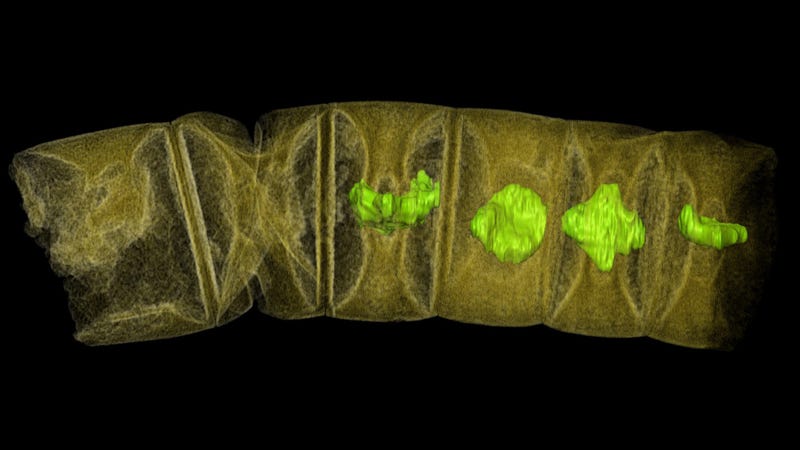
Swedish researchers say they’ve discovered traces of ancient red algae preserved in sedimentary rock dating back 1.6 billion years, making them the oldest plant-like fossils ever found. The discovery shows that complex multicellular life appeared in Earth’s history much earlier than previously thought.
Two kinds of fossils, both found in the Chitrakoot region of central India, were analyzed by Stefan Bengtson and his team from the Swedish Museum of Natural History. Using an impressive array of imaging techniques, the researchers identified physical characteristics consistent with red algae, a primitive form of plant-like life capable of photosynthesis, and one of the first forms of complex life to emerge on Earth. The fossils are an astounding 400 million years older than the previous record holder for a plant-like fossil, indicating an earlier origin for advanced multicellular life. This research now appears in PLOS Biology.
Life got started on our planet shortly after the formation of Earth some 3.77 billion years ago. A recent study offered new evidence showing that this simplest form of life—single celled organisms called prokaryotes—could have emerged near deep sea hydrothermal vents.Life remained in this very simple form for another 2.5 billion years, though the first photosynthetic bacteria emerged 3.4 billion years ago, and the first multicellular organisms appeared some time between 2.1 and 2.7 billion years ago, including oxygen-producing cyanobacteria. Then, during the Proterozoic Era, advanced multicellular organisms called eukaryotes, with more specialized cells, finally emerged.
Among these primordial creatures was red algae, a mostly marine group of seaweeds representing a primitive branch of plants. They were some of the earliest plant-like organisms on the planet, containing green chloroplasts that allowed for photosynthesis, and other light-gathering pigments that give the algae their characteristic red color. Prior to this new discovery, the oldest known algae fossil—another red algae called Bangiomorpha—was dated at 1.2 billion years old.
“This discovery puts the clock back for major evolutionary events,” Bengtson told Gizmodo. “The new finds are 400 million years older than Bangiomorpha and suggest that advanced multicellularity appeared at least a billion years before the ‘Cambrian explosion’, when multicellular organism diversified and took on a major role in the ecosystems. We shall probably have to reevaluate the timing of appearance of major lineages in the tree of life.” Other multicellular organisms likely existed at this time, but nothing as biologically sophisticated as algae.
The red algae was found embedded in fossil mats of cyanobacteria, called stromatolites, in ancient Indian phosphorite. Using synchrotron-based X-ray tomographic microscopy, scanning electron microscopy, and other scanning techniques, the researchers identified features consistent with plant-like organisms.
“We found two kinds, the thread-like Rafatazmia and the fleshy Ramathallus,” said Bengtson. “The thread-like ones are about the thickness of a human hair, consisting of chains of cells, typically with some kind of pore or plug in the dividing wall between the cells. Rhomboidal [four-sided] platelets occupy the center of each cell; these are interpreted as parts of the chloroplasts.”
He says the fleshy fossils grew in complex colonies consisting of finger-like protrusions, and that the tissues were comprised of tightly-packed, cell-chain filaments called “cell fountains.” No internal structures were detected, except for some strange globular features of an unknown nature.
When it was alive, the thread-like algae would have appeared as tufts of hair swimming in the surface water of the Earth’s oceans, possibly attached at one end. The fleshy ones would looked like oddly shaped clumps in microbial mats bathed in cyanobacteria. These primordial, multi-celled organisms lived in shallow marine water at a time when the sea-floor was dominated by rounded pillar-like stromatolites
“Like modern algae, the fossil forms would be effective photosynthesizers, building organic matter using the energy from sunlight,” said Bengtson. “Plants are responsible for most of the oxygen-producing photosynthesis today, and we are looking at the beginning of this life-giving process, though it probably took another billion years before plants became dominant.”
Interestingly, red algae was a kind of dead end as far as biological diversity is concerned; as far as we know, only red algae is descended from red algae. Green algae, which split off from a common ancestor, eventually gave rise to land plants.
Peter Wilf, a paleobotanist at Penn State’s Department of Geosciences who wasn’t involved in the new study, says the new fossils are “spectacular.”
“Without doubt they provide a wealth of new information about the timing of eukaryote evolution, potentially pushing significant evolutionary events several hundred million years back in time,” Wilf told Gizmodo. “They demonstrate once again that fossils provide the only physical evidence of life’s evolution through geologic time and remind us that most fossils remain undiscovered.”
Looking ahead, Bengston’s team would like to find more traces of multicellular lifeforms in the rocks of other regions.
[PLOS Biology]
